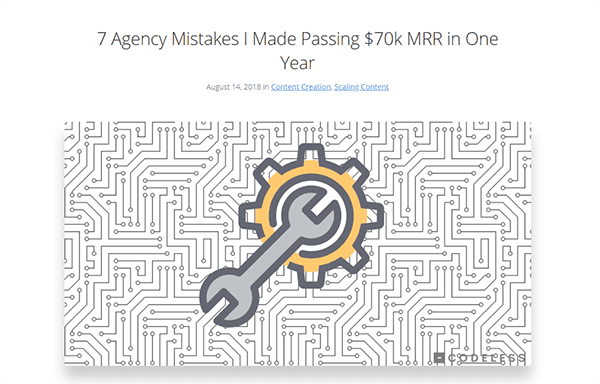Do you want your customers to engage with your brand? We all do.
But I don’t mean simply liking your latest Tweet or sharing a post you made on Facebook—I mean really engaging. As in, taking an interest in the history of your company, knowing some of the people who work there, and having a deeper understanding of the how and why your company came to be.
Brand storytelling (using narrative to connect your brand to customers) is the proverbial steel for building the bridge between company and consumer. It allows companies to tap into the basic human love of stories—especially underdog tales of real people beating the odds—to build authentic connections.
According to Edelman’s 2014 Brandshare study, 87% of customers want to develop more meaningful relationships with brands. However, 66% of respondents in that study said that they see their relationship with brands as a one-way street—where they share information about themselves and never receive that same type of sharing from brands.
Consumers are hungry for brands that allow them to develop real understanding and loyalty. But to do that, you as a brand must share enough to give customers an appreciation of your journey.
Content marketing has never been more crowded than it is today. Nine in ten B2B businesses publish content, which means we’re constantly vying for readers’ attention. According to a study from Influence & Co., the average reader viewed a resource for about two minutes and only consumed 53% of an average piece of content.
To grab the attention of consumers, you’ll have to stand out.
The Power of Storytelling
The best writers and speakers all have something in common—they are great storytellers. They have the power to delight, touch, inspire, challenge, and motivate. They help us to create a narrative picture in our minds that help us to see how an event took place.
Stories are all around us. The movies and television we watch, news articles we read, and conversations we have—we expect them to form the bases of our relationships. According to a study by Jeremy Hsu, personal stories and gossip on average make up 65% of our conversations. They represent a human need to understand and connect emotionally with how and why things happen. According to an infographic published by OneSpot, 92% of consumers want brands to make ads that feel like a story when consumed.
How to Tell Brand Stories
At their most basic level, brand stories are your unique connection to your audience.
What starts out as a series of facts can eventually yield larger narratives that grab the reader’s attention. But figuring out how to tell branded stories can be difficult. It may take a little brainstorming to find where the story lies within the facts.
Before you begin, outline some baseline facts about your business. The deeper you dive into this exercise, the more ideas will float to the top.
- Who you are: How did your company come to exist? What are your company’s vision, mission, values, and culture? What kind of people typically work at your company?
- What you do: What is the product or service that you provide? What kind of interactions with customers (or the general public) does providing that product or service create? How has that led to lessons learned?
- Who you do it for: Who do you help? Case studies and customer success stories make for very powerful brand storytelling content. They can aid in connecting the dots for potential customers and guide them to see how you can assist them in the same way that you have helped others.
- Why you do what you do: What is your larger goal? What led to your company to offer the products and services it does? What are the benefits to your customer?
- How you do what you do: How is the product or service created and delivered? Put your painstaking process on full display for your audience so they understand the care and craftsmanship that go into the production process.
- Where you are headed: What is next? Is your product going to evolve and change? Will you be broadening the type of customers that you help? Is your company philosophy or vision going through a change?
By examining these ideas and questions, you should bring some great story ideas to the surface. Here’s how to craft and create effective stories for any piece of brand content that you create.
Your Stories Must Be Driven By Personalities
No one cares to read a laundry list of events that took place. It doesn’t provide any insight. Where’s the hero? The villain? The drama? Where are the odds that were overcome? Real stories come from not what happened but how our protagonist and side characters were emotionally affected.
Let’s say you are a founder of a successful software product. Your story is that you worked for a manufacturing company but was laid off with a decent severance package, giving you a few months of runway to chase your dreams. Despite slim chances, you overcame the odds and today your company has millions in annual revenue and an amazing team of employees working to grow the business.
Interesting? Maybe a little, but it’s pretty cliche. There are thousands of stories like that one.
The unique and interesting part of that story isn’t what happened but rather how you felt as the founder.
How did getting laid off make you feel? What challenges did you face in the journey to success? How did you overcome the odds and how did you react to the roadblocks that impeded you?
Let the personalities drive the stories that you tell, not the actions that took place.
Keep It Simple
Save the twisting and turning narratives for movies and books. In branded storytelling, you should keep things as simple as possible. Focus on the problem, solution, and success within the story that you tell.
The problem should be the focus of the beginning of the story. The solution is the middle. Success is the end. Using this three-part model helps you to follow a conventional narrative model while ensuring that you don’t stray too far from the most important aspects of the narrative.
Brand storytelling doesn’t have to be complex.
Expanding the Reach of Your Stories
Telling great stories is only helpful if people actually read them. The good news is that interesting stories are a great way to catch someone’s eye.
Use Stories to Build Your Personal Brand
Use your own stories to build your personal brand while creating branded content and encourage your team to do the same. Then, leverage these personal brands to grow the viewership for your company’s branded content. The two feed off of each other.
Use Social Media to Grow Readership
Stories perform well on social media. Use snippets, quotes, and anecdotes to give viewers a sneak peek into the content of each story. Over time these stories will become synonymous with your brand.
Tell the Story Everywhere That You Possibly Can
When you publish a brand story, tell that story everywhere you can, such as in your speeches and interviews, podcasts and guest posts. Find ways to infuse the most interesting stories you have into other forms of media to improve their reach, and infuse those stories with how people perceive your brand.
Encourage Your Customers to Tell Your Stories
Customers love to attach stories to the brands they love. A favorite brand isn’t just a brand. It’s something the founder started in their garage, or that uses only 100% recycled materials to be green. By making your stories part of your brand identity, you encourage customers to share them. This kind of information sharing goes a lot further to build awareness than a simple product recommendation ever could.
To link your most important stories with your brand, they must become the things that your customers, the media, and advocates mention when they explain your company and product.
Three Examples of Effective Brand Storytelling
Codeless Founder Shares Agency Growth Story

Brad Smith is the founder of Codeless, a content creation agency. He shared the story of their growth to more than $70k MRR by sharing the seven biggest mistakes they made along the way. The article tells the story of how their agency came to be, and each mistake highlights a roadblock they faced along the way.
This is a great example because the story is told in a way that will appeal to several audiences. Customers want to hear the story of how the agency came to be, while other agency owners and potential partners want to learn from their mistakes. By highlighting its bumpy journey, Codeless is able to deliver a compelling brand story that never feels promotional.
Airbnb Celebrates New Years with Customer Success Stories
Airbnb is a great brand to turn to when you want a great example of highly effective brand storytelling. A 2015 video celebrated more than 550,000 users renting a place to stay in more than 20,000 cities for the new year. As a result of this campaign, they enjoyed a lot of high-profile media coverage that helped them to further their brand awareness.
IBM Shares Shares How Their AI Solution Watson Can Save Lives

IBM has led the way in AI innovation for quite some time. You might have heard about their Watson system when it appeared on the game show Jeopardy, but IBM has been highlighting how the ultra-advanced system had been providing other benefits in their recent brand content.
In a case study, IBM detailed how the artificial intelligence was 31% more accurate than doctors using their naked eye at diagnosing melanoma, a common form of skin cancer. Highlighting a particular, widely appealing application made the story engaging while also hinting to potential buyers at the AI’s broad potential for application across industries.
Stories Shape Brands
When stories are powerful enough, they become a living, breathing part of your brand that can serve a rallying cry for employees, customers, and advocates. Consider how using brand storytelling can help your brand to better connect with your audience and give your company an interesting way to present itself to new prospective customers.
